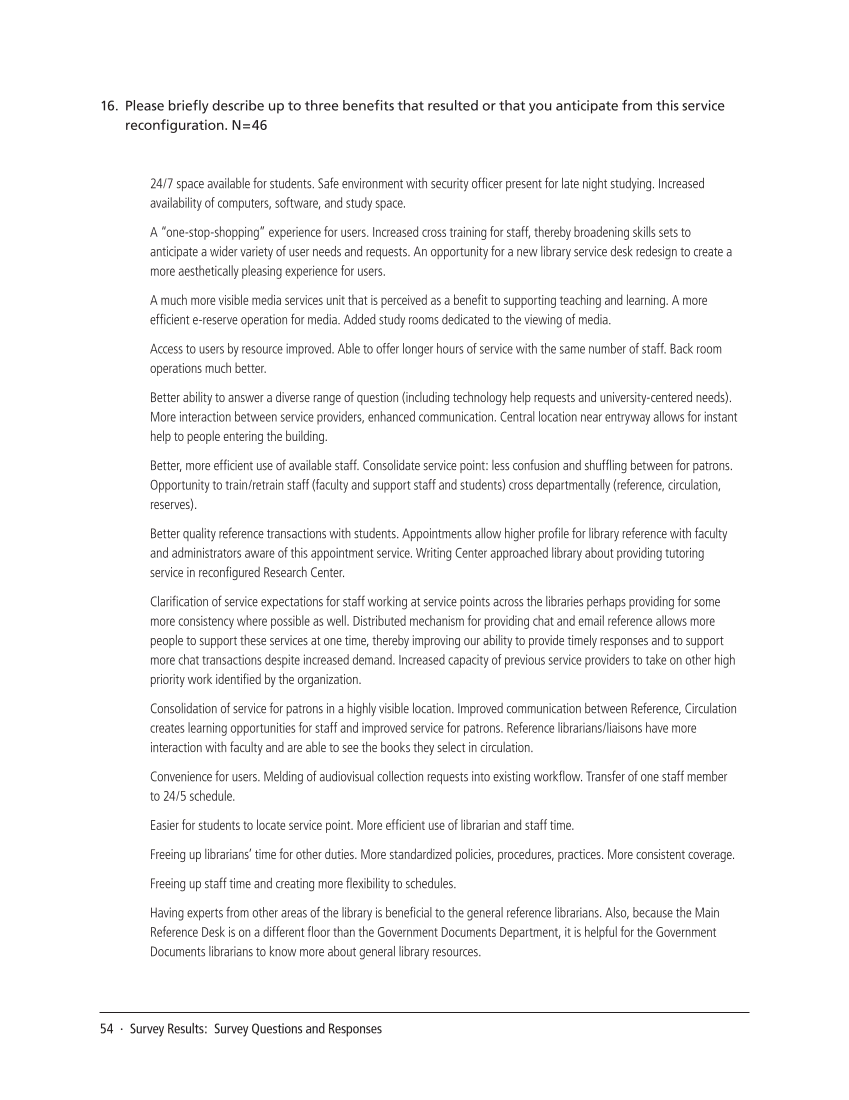54 · Survey Results: Survey Questions and Responses
16. Please briefly describe up to three benefits that resulted or that you anticipate from this service
reconfiguration. N=46
24/7 space available for students. Safe environment with security officer present for late night studying. Increased
availability of computers, software, and study space.
A “one-stop-shopping” experience for users. Increased cross training for staff, thereby broadening skills sets to
anticipate a wider variety of user needs and requests. An opportunity for a new library service desk redesign to create a
more aesthetically pleasing experience for users.
A much more visible media services unit that is perceived as a benefit to supporting teaching and learning. A more
efficient e-reserve operation for media. Added study rooms dedicated to the viewing of media.
Access to users by resource improved. Able to offer longer hours of service with the same number of staff. Back room
operations much better.
Better ability to answer a diverse range of question (including technology help requests and university-centered needs).
More interaction between service providers, enhanced communication. Central location near entryway allows for instant
help to people entering the building.
Better, more efficient use of available staff. Consolidate service point: less confusion and shuffling between for patrons.
Opportunity to train/retrain staff (faculty and support staff and students) cross departmentally (reference, circulation,
reserves).
Better quality reference transactions with students. Appointments allow higher profile for library reference with faculty
and administrators aware of this appointment service. Writing Center approached library about providing tutoring
service in reconfigured Research Center.
Clarification of service expectations for staff working at service points across the libraries perhaps providing for some
more consistency where possible as well. Distributed mechanism for providing chat and email reference allows more
people to support these services at one time, thereby improving our ability to provide timely responses and to support
more chat transactions despite increased demand. Increased capacity of previous service providers to take on other high
priority work identified by the organization.
Consolidation of service for patrons in a highly visible location. Improved communication between Reference, Circulation
creates learning opportunities for staff and improved service for patrons. Reference librarians/liaisons have more
interaction with faculty and are able to see the books they select in circulation.
Convenience for users. Melding of audiovisual collection requests into existing workflow. Transfer of one staff member
to 24/5 schedule.
Easier for students to locate service point. More efficient use of librarian and staff time.
Freeing up librarians’ time for other duties. More standardized policies, procedures, practices. More consistent coverage.
Freeing up staff time and creating more flexibility to schedules.
Having experts from other areas of the library is beneficial to the general reference librarians. Also, because the Main
Reference Desk is on a different floor than the Government Documents Department, it is helpful for the Government
Documents librarians to know more about general library resources.
16. Please briefly describe up to three benefits that resulted or that you anticipate from this service
reconfiguration. N=46
24/7 space available for students. Safe environment with security officer present for late night studying. Increased
availability of computers, software, and study space.
A “one-stop-shopping” experience for users. Increased cross training for staff, thereby broadening skills sets to
anticipate a wider variety of user needs and requests. An opportunity for a new library service desk redesign to create a
more aesthetically pleasing experience for users.
A much more visible media services unit that is perceived as a benefit to supporting teaching and learning. A more
efficient e-reserve operation for media. Added study rooms dedicated to the viewing of media.
Access to users by resource improved. Able to offer longer hours of service with the same number of staff. Back room
operations much better.
Better ability to answer a diverse range of question (including technology help requests and university-centered needs).
More interaction between service providers, enhanced communication. Central location near entryway allows for instant
help to people entering the building.
Better, more efficient use of available staff. Consolidate service point: less confusion and shuffling between for patrons.
Opportunity to train/retrain staff (faculty and support staff and students) cross departmentally (reference, circulation,
reserves).
Better quality reference transactions with students. Appointments allow higher profile for library reference with faculty
and administrators aware of this appointment service. Writing Center approached library about providing tutoring
service in reconfigured Research Center.
Clarification of service expectations for staff working at service points across the libraries perhaps providing for some
more consistency where possible as well. Distributed mechanism for providing chat and email reference allows more
people to support these services at one time, thereby improving our ability to provide timely responses and to support
more chat transactions despite increased demand. Increased capacity of previous service providers to take on other high
priority work identified by the organization.
Consolidation of service for patrons in a highly visible location. Improved communication between Reference, Circulation
creates learning opportunities for staff and improved service for patrons. Reference librarians/liaisons have more
interaction with faculty and are able to see the books they select in circulation.
Convenience for users. Melding of audiovisual collection requests into existing workflow. Transfer of one staff member
to 24/5 schedule.
Easier for students to locate service point. More efficient use of librarian and staff time.
Freeing up librarians’ time for other duties. More standardized policies, procedures, practices. More consistent coverage.
Freeing up staff time and creating more flexibility to schedules.
Having experts from other areas of the library is beneficial to the general reference librarians. Also, because the Main
Reference Desk is on a different floor than the Government Documents Department, it is helpful for the Government
Documents librarians to know more about general library resources.






















































































































































































































